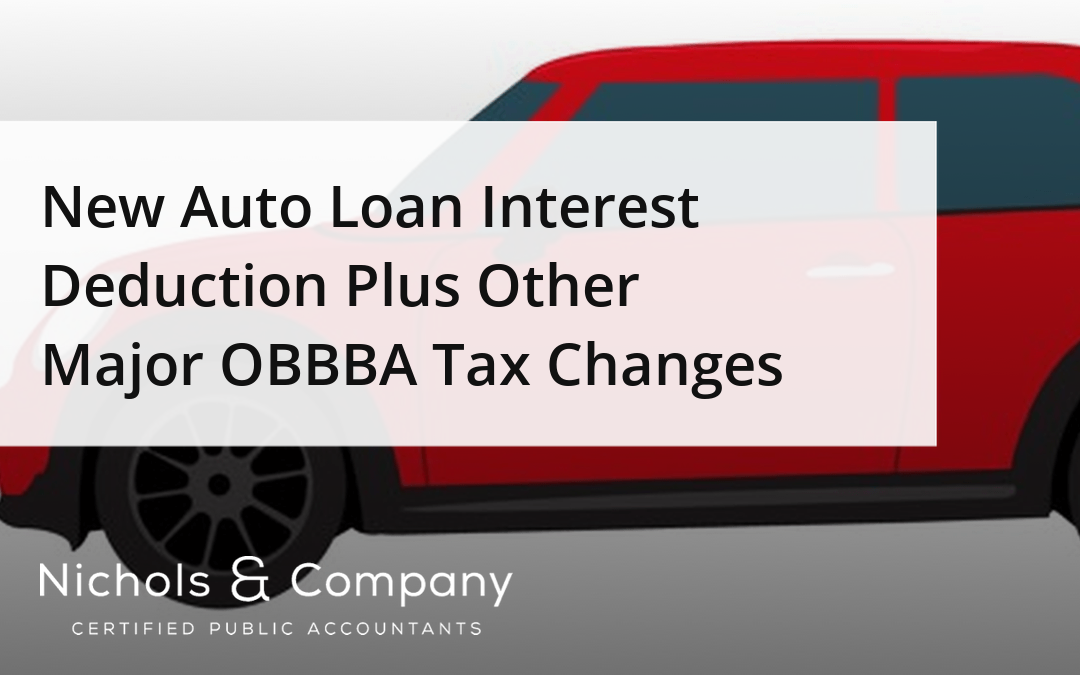If you've been thinking about buying a new car, truck, or motorcycle, there's some good news on the tax front. The One Big Beautiful Bill Act (OBBBA) created a brand-new deduction that could save you money on your taxes—but only for a limited time.
This temporary provision allows eligible taxpayers to deduct up to $10,000 per year in interest paid on loans for new, personal-use vehicles. Here's what you need to know to make the most of this opportunity.
What Makes This Deduction Special?
Prior to this new law, interest on personal vehicle loans wasn't deductible at all. Tax-deductible interest was limited to mortgages, investments, and student loans. This new provision changes that—temporarily—to provide tax relief while supporting the domestic automobile industry during a period of elevated vehicle prices and interest rates.
The best part? This is an "above-the-line" deduction, which means you can claim it whether you itemize deductions or take the standard deduction. It's available for tax years 2025 through 2028.
Do You Qualify?
To take advantage of this deduction, both you and your vehicle purchase must meet specific requirements.
Loan Requirements:
- The loan must originate after December 31, 2024
- The loan must be secured by a lien on the vehicle
- Loans from family members or related parties don't qualify
Vehicle Requirements:
- Must be new—you must be the first owner
- Must be for personal use only (not business or commercial)
- Must have a gross vehicle weight rating under 14,000 pounds
- Must be finally assembled in the United States (verified by VIN)
- Includes cars, minivans, SUVs, pickup trucks, vans, and motorcycles
- Used vehicles, leased vehicles, and salvage title vehicles don't qualify
Income Limits Apply
Like many tax benefits, this deduction phases out at higher income levels:
- Single filers: Phase-out begins at $100,000 modified adjusted gross income (MAGI), fully phased out at $150,000
- Married filing jointly: Phase-out begins at $200,000 MAGI, fully phased out at $250,000
The deduction reduces by $200 for every $1,000 of MAGI above the threshold.
Important Documentation
Keep excellent records if you plan to claim this deduction:
- Loan statements showing interest paid
- Vehicle documentation proving U.S. assembly
- Your lender will provide a 1098 statement showing annual interest paid
- You'll need to report the Vehicle Identification Number (VIN) on your tax return
But Wait, There's More: Enhanced Standard Deductions
The auto loan interest deduction is just one piece of the OBBBA puzzle. The new law also makes permanent and slightly increases the standard deduction amounts, providing additional tax relief for most taxpayers:
- Single filers: $15,750 (up from $15,000)
- Married filing jointly: $31,500 (up from $30,000)
- Head of household: $23,625 (up from $22,500)
If you're 65 or older, you get additional standard deduction amounts: $2,000 for unmarried individuals or $1,600 for married individuals filing jointly. These amounts will continue to be adjusted annually for inflation.
Plus, there's a brand-new $6,000 deduction available for taxpayers age 65 and older from 2025 through 2028. This deduction is available whether you itemize or take the standard deduction, though it phases out at higher income levels starting at $75,000 for single filers and $150,000 for joint filers.
Major Changes to the SALT Deduction
For taxpayers who itemize deductions, particularly those in high-tax states, the OBBBA brings significant relief to the state and local tax (SALT) deduction. The cap temporarily increases from $10,000 to $40,000 for tax years 2025 through 2029 ($20,000 for married filing separately).
However, this expanded benefit comes with income restrictions. The higher cap begins to phase out when your modified adjusted gross income exceeds $500,000 ($250,000 for separate filers). The deduction reduces by 30% of the income above this threshold, but it never drops below the original $10,000 floor.
This change could provide substantial tax savings for homeowners with large property tax bills or high earners in states with income taxes.
Strategic Planning Opportunities
These combined changes create several planning opportunities:
Vehicle Purchase Timing: If you're planning to buy a qualifying vehicle, doing so before the auto loan interest deduction expires in 2028 could provide meaningful tax savings.
Deduction Strategy: With higher standard deduction amounts and the temporary SALT cap increase, it's worth recalculating whether itemizing or taking the standard deduction provides better tax savings for your situation.
Income Management: Many of these new benefits have income-based phase-outs, making strategic income timing and deduction planning more important than ever.
The Bottom Line
The OBBBA creates a complex but potentially rewarding tax landscape for 2025 and beyond. If you have questions about how any of these items will affect your tax situation for 2025 and beyond, please don't hesitate to reach out to your accountant or our office at 614-891-5423. We would be glad to discuss your specific circumstances and make sure you're positioned to take full advantage of these temporary but valuable tax breaks.

